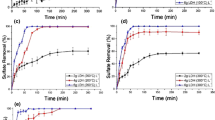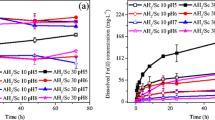Abstract
Hydrocalumite, a calcium aluminate hydrate phase, consists of positively-charged structure units, and is therefore an ideal candidate for accommodating anionic contaminants. In this study, a series of batch experiments was carried out to examine the uptake of chromate and selenate by hydrocalumite. To determine the uptake capacity and long-term stability, hydrocalumite solid solutions between chromate/selenate and hydroxyl were synthesized over a reaction time of more than one year. At a ratio of water to initial solids added (CaAI2O4+CaO) of 75:1, the maximum uptake capacities were over 77 and 114 g/kg for Cr and Se, respectively. These values are very close to the theoretical uptake capacities of chromate and selenate hydrocalumite end members (81 and 118 g/kg, respectively). The oxyanion removal efficiency from solution was above 95%. Due to the high uptake capacity and anion removal efficiency of hydrocalumites, their application in wastewater treatment is promising. Hydrocalumites are also important hydration products of cementitious materials, the long-term stability of these phases is of significance for application in solidification/stabilization technology.
Similar content being viewed by others
References
Taylor, H. F. W., Crystal structures of some double hydroxide minerals, Mineralogical Magazine, 1973, 39: 377–389.
Nriagu, J. O., Nieboer, E., ed., Chromium in the Natural and Human Environments, Advances in Environmental Science and Technology, New York: John Wiley & Sons, Vol. 20, 1988, 571.
Adriano, D. C., Page, A. L., Elseewi, A. A., Chang, A. C., Straughan, I., Utilization and disposal of fly ash and other coal residues in terrestrial ecosystems: A review, Journal of Environmental Quality, 1980, 9: 333–344.
Zhang, M., Reardon, E. J., Removal of B, Cr, Mo, and Se from wastewater by incorporation into hydrocalumite and ettringite, Environmental Science and Technology, 2003, 37: 2947–2952.
Kindness, A., Macias, A., Glasser, F. P., Immobilization of chromium in cement matrices, Waste Management, 1994, 14: 3–11.
Baur, I., Johnson, C. A., Sorption of selenite and selenate to cement materials, Environmental Science and Technology, 2003, 37: 3442–3447.
Kingsley, J. J., Suresh, K., Patil, K. C., Combustion synthesis of fine-particle metal aluminates, Journal of Materials Science, 1990, 25: 1305–1312.
Roberts, M. H., Calcium aluminate hydrates and related basic salt solid solutions, Proceedings of the fifth International Congress on the Chemistry of Cements, Tokyo, 1969, II: 104–117.
Kuzel, H. J., X-ray investigation of some complex calcium aluminate hydrates and related compounds, Proceedings of the fifth International Congress on the Chemistry of Cements, Tokyo, 1969, II: 92–97.
Perkins, R. B., Palmer, C. D., Solubility of chromate hydrocalumite (3CaO·Al2O3·CaCrO4·nH2O) 5–75 °C, Cement and Concrete Research, 2001, 31: 983–992.
Taylor, H. F. W., Cement Chemistry, 2nd ed., London: Thomas Telford Services, 1997, 459.
Li, G., Le Bescop, P., Moranville-Regourd, M., Synthesis of the U phase (4CaO·0.9Al2O3·1.1SO3·0.5NaO-16H2O), Cement and Concrete Research, 1997, 27: 7–13.
Hassett, D. I., McCarthy, G. J., Kumarathasan, P., Pflughoeft-Hassett, D., Synthesis and characterization of selenate and sulfate-selenate ettringite structure phases, Materials Research Bulletin, 1990, 25: 1347–1354.
Reardon, E. J., An ion interaction model for the determination of chemical equilibria in cement/water systems, Cement and Concrete Research, 1990, 20: 175–192.
Jones, F. E., Hydration of calcium aluminates and ferrites, Proceedings of the 4th International Congress on Chemistry of Cements, Washington, 1960, I: 205–246.
Turriziniani, R., The calcium aluminate hydrates and related compounds, in The Chemistry of Cements, London: Academic Press, 1964, Vol.1, 233–286.
Steinour, H. H., Aqueous cementitious systems containing lime and alumina, PCA Bulletin, 1951, 34: 1–100.
Glasser, F. P., Chemistry of cement-solidified waste forms, in Chemistry and Microstructure of Solidified Waste Forms (Spence, R. D. ed.), Boca Raton: Lewis Publishers, 1993, 1–39.
Clark, B. A., Brown, P. W., The formation of calcium sulfoaluminate hydrate compounds, Cement and Concrete Research, 1999, 29: 1943–1948.
Zhang, M., Incorporation of oxyanionic B, Cr, Mo, and Se into hydrocalumite and ettringite: Application to cementitious systems, Ph.D. Dissertation. University of Waterloo, Waterloo, Ontario, Canada. 2000, 172.
Gabrisová, A., Havlica, J., Sahu, S., Stability of calcium sulphoalumina hydrates in water solutions with various pH values, Cement and Concrete Research, 1991, 21: 1023–1027.
Author information
Authors and Affiliations
Corresponding author
Rights and permissions
About this article
Cite this article
Zhang, M., Reardon, E.J. Chromate and selenate hydrocalumite solid solutions and their applications in waste treatment. Sci. China Ser. C.-Life Sci. 48 (Suppl 1), 165–173 (2005). https://doi.org/10.1007/BF02889815
Received:
Issue Date:
DOI: https://doi.org/10.1007/BF02889815




